What we do
Services
Experts in
In 2022, the number of emails sent and received per day worldwide reached 333.2 billion. Considering that there are around 4 billion email users, we can reasonably assume that not all of these emails were sent manually. The fact is that the vast majority of businesses now use SaaS email marketing services that allow them to automate the sending of all types of emails.
If you are considering starting your own email marketing platform, there's a good chance you can find an audience. Of course, this will require a lot of hard work, well-developed solutions, and finding inspiration from successful startups. And if you’re looking to build a SaaS email marketing platform, it’s hard to imagine a better example to look to than Mailchimp.
Mailchimp entered the market in 2001, when there already were a few large email marketing platforms dominating the market and people perceived promotional emails as never-ending spam attacking their inboxes. Still, even under such circumstances, Mailchimp’s founders managed to build a loyal user base of around 14 million users (as of 2020) and to sell the company to Intuit for $12 billion in 2021.
Mailchimp’s path wasn’t easy. That’s why there’s so much to learn from Mailchimp for those whose purpose is to blow up the MarTech industry with a new email marketing platform. What should you do to achieve this? Read our article to find out.
The history of Mailchimp started back in 2000, when Ben Chestnut and Dan Kurzius founded a web design agency called Rocket Science Group that focused on corporate clients. Some of their clients started to ask about a convenient way to send emails to their customers, leading Ben and Dan to the idea of creating an email marketing service for small businesses that couldn’t afford existing email marketing services (which were quite expensive in the early 2000s). In 2001, Ben Chestnut and Dan Kurzius started Mailchimp.
In many ways, their journey mirrors that of other innovators in AdTech development services, where a specific client pain point inspires a broader, scalable solution. What began as a side project soon evolved into a fully-fledged platform that changed how small businesses approached digital marketing.
For the next five years, Ben and Dan ran Rocket Science Group and Mailchimp simultaneously.But their web design agency grew slowly, and over time their passion for it waned. In 2006, they started to ask if it was worth dedicating all of their time to their side project.
At the time, there already were successful email marketing platforms taking leading market positions, but Ben Chestnut and Dan Kurzius still decided to shut down Rocket Science Group and start working solely on Mailchimp.
Though the founders were offered millions of dollars in funding to become another oversized, expensive email service, they kept slowly shaping Mailchimp’s concept and features according to their own vision.
Every time we sat down with potential investors, they never seemed to understand small business.
— Ben Chestnut, New York Times interview
Serving small businesses, Mailchimp gained an advantage over their larger and richer opponents: they offered cheaper email marketing tools than other email marketing platforms. And their patience and dedication eventually paid off.
In 2021, Mailchimp had 13 million users and $800 million in revenue, while Constant Contact, Mailchimp’s biggest competitor in 2001, had only 600,000 users and $331.7 million in revenue. Quite a significant difference, right?
In an interview for the Financial Times in September 2021, Ben Chestnut mentions that, at the beginning, he was thinking about selling Mailchimp for around $4 million. On September 13, 2021, Intuit acquired Mailchimp for $12 billion. It was the highest price ever paid to acquire a bootstrapped company.
Mailchimp still continues its path as an email marketing platform targeted at small businesses.
The whole point of this business is to prove to small businesses that you can do this, because we did it
— Ben Chestnut, New York Times interview
Now, Mailchimp is used by small businesses such as Robo 3D (a 3D printing business), Bingo Card Creator (a board game business), FLXCUF (a fashion accessories brand), Concept Marketing Group (a marketing agency), and others. Ben claims that he is still not interested in building a service for bigger clients.
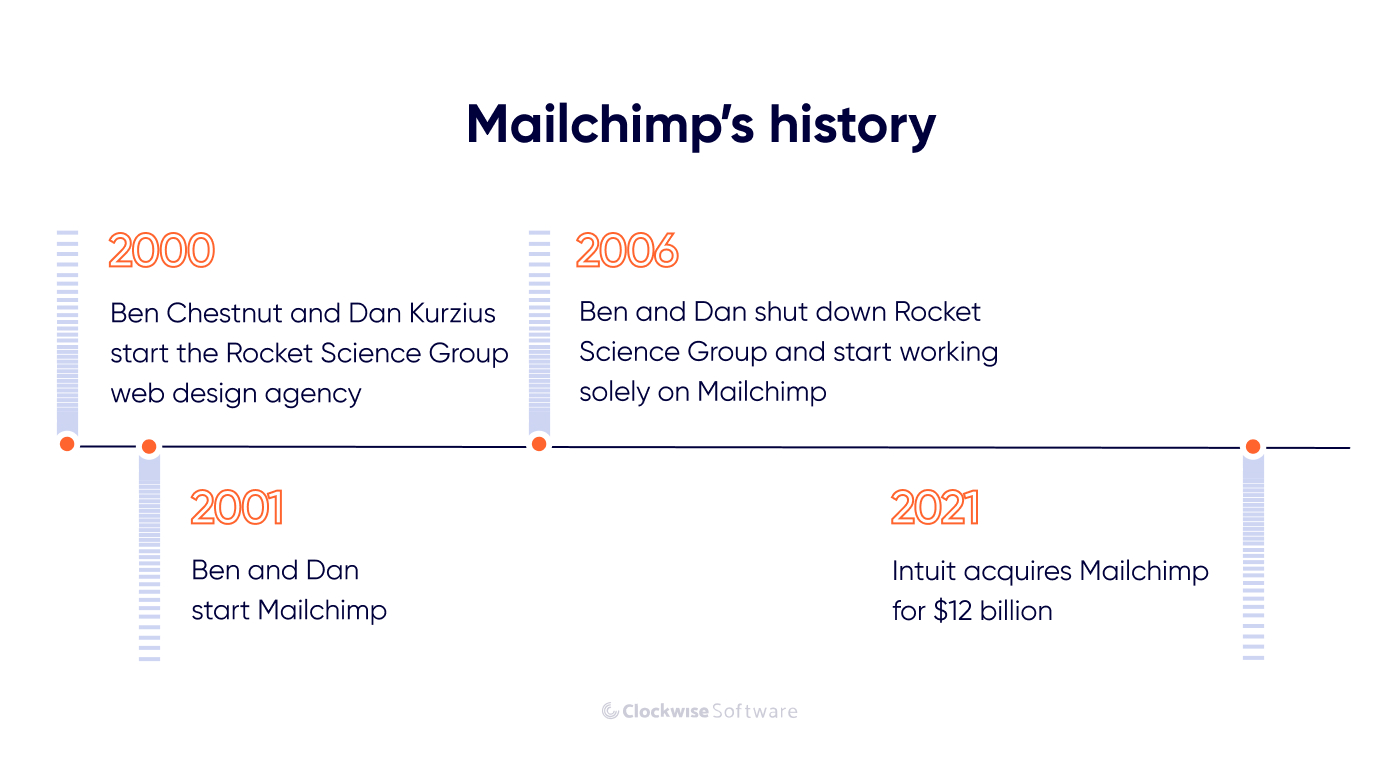
Mailchimp has many email marketing features that allow users to stay customer-oriented, better understand their target audience, analyze email campaigns, make plausible predictions, extend their user base, and simply grow their business.
Let’s take a closer look at the fundamental features of Mailchimp that any modern SaaS email marketing platform should have.
A customer profile gives in-depth information about a customer and their activity, preferences, and purchase history. It’s a more effective way to find out how customers interact with each campaign than simply looking at performance reports.
The Mailchimp founders understand that their users aren’t designers or developers. That’s why the platform offers professional-looking, highly customizable templates so users can focus on the content, not the design. A convenient drag-and-drop email editor makes it extremely easy to create stylish marketing messages for different campaigns, making Mailchimp suitable for any type of brand. And if the provided templates are not enough, Mailchimp allows users to code their own.
Mailchimp is one of the platforms that made email marketing automation popular and widely used.
Mailchimp can automatically send a single email or a sequence of emails: for example, when someone purchases a product or subscribes to a newsletter. It offers a wide array of preset automation types with built-in triggers.
Email automation reduces manual work by automating repetitive tasks. Mailchimp reports that 3,660,438,963 automations were sent by Mailchimp customers in 2020.
Recipient segmentation ensures that users are sending relevant messages to each customer, making offers more personalized. Mailchimp segmentation tools allow users to target people in accordance with their activity, traits, and interests. Thanks to this, businesses have a greater chance of meeting their goals. Recently, Mailchimp has added the possibility to target customers via Instagram ads. In order to make the lives of small businesses even easier, Mailchimp also offers prebuilt segments that can be used for common targeting strategies.
Message scheduling allows for automatically sending messages to the right recipient at the right time.
It gives Mailchimp users the ability to write emails in advance and schedule their delivery a few minutes or months ahead. This significantly optimizes the work processes of small businesses.
The message scheduling feature is also helpful for users who need to reach customers in different time zones. No matter in which country a recipient lives, thanks to message scheduling, they can get the same email at the same time of the day as all other recipients.
Mailchimp empowers businesses to monitor and analyze the success of their campaigns. This feature is vital for optimizing and upgrading users’ marketing efforts. Mailchimp users can choose the most important key performance indicators (open rate, click rate, conversion rate, unsubscribes, and others) to evaluate their ongoing performance and act accordingly to improve it.
Mailchimp has over 300 integrations, allowing users to seamlessly use other marketing tools within the platform. This gives more opportunities for reaching out to customers, increasing sales, and so on. These integrations include messaging platforms (LiveChat, SimpleTexting, Zendesk Activity), social media platforms (LinkedIn, Facebook, Vimeo), design platforms (Canva, Adobe Photoshop, Splash), developer-friendly tools (WordPress, Mixpanel, Firebase), and dozens of other useful tools.
Mailchimp is a huge multi-component platform that has grown from scratch to the second most widely used email service provider for ERPs in the world (after Salesforce Marketing Cloud) and is considered one of the best marketing automation software products on the market. It’s definitely worth learning from it while creating your own automated email service like Mailchimp.
If you want to recreate the success of Mailchimp and build your own email marketing platform, keep reading for our step-by-step guide on how to do so. This guide is based on our own use of MarTech services to build software products for MarTech startups.
Now that you know the details of Mailchimp’s success and the platform’s key features, we can get down to development itself. In this section, we overview the main stages of the development process, from idea to release and beyond.
Mailchimp is one of dozens of successful email marketing platforms. And all of them are your potential competitors. They are the reason why it is worth starting your project with market research.
Imagine you have shortlisted features for your email service like Mailchimp and have launched the development process. But then you find out that a service that offers exactly these features already exists and has a few hundred thousand users across the world. Why should users switch to your product that has just launched?
By starting with market research, you can identify risks, think of strategies to overcome your competitors, discover new business ideas, save yourself from making poor decisions, and strategize about gaining a loyal user base. Market research can be divided into three parts:
The state of any industry is hardly static. For example, when Mailchimp entered the market, there weren’t email marketing services offering accessible solutions for small businesses. But now, there are a lot of SaaS email marketing platforms with pricing that small and midsize businesses (SMBs) can afford. So you should do your homework before entering the industry:
Market research is a complex and meticulous process that requires a fair amount of time and resources. You can dedicate this task to a business analyst, IT consulting company, or MarTech development company. However, if you’re planning to handle it yourself, we suggest reading detailed information about how to do market research in our previous article.
Keep in mind that if you want your product to be competitive, it has to offer something your competitors can’t or be better in some aspects than your competitors products. To find your unique selling proposition (a unique benefit that your service offers to customers), you have to:
As you've found a unique selling proposition of your product and analyzed your competitors, you can proceed to customer research.
The key to a software product’s success lies in meeting customers’ needs. You have to define your ideal customer and focus your development process on building a service that exactly this customer wants to use. Your tasks are to:
After you’ve gathered the necessary information about the current state of the market, you can proceed with outlining your product itself.
You can’t start creating a plan of how to bring your idea to life and build a development strategy without shaping your idea and filling it in with essential details. Your development team, partners, stakeholders, investors, and everyone else involved in your project need to have a clear understanding of the product you want to create.
Answer a few essential questions to make sure there are no gaps in your product vision and that you’re ready to proceed to development. To gather all the details of your project in one place, you can fill in a business model canvas.
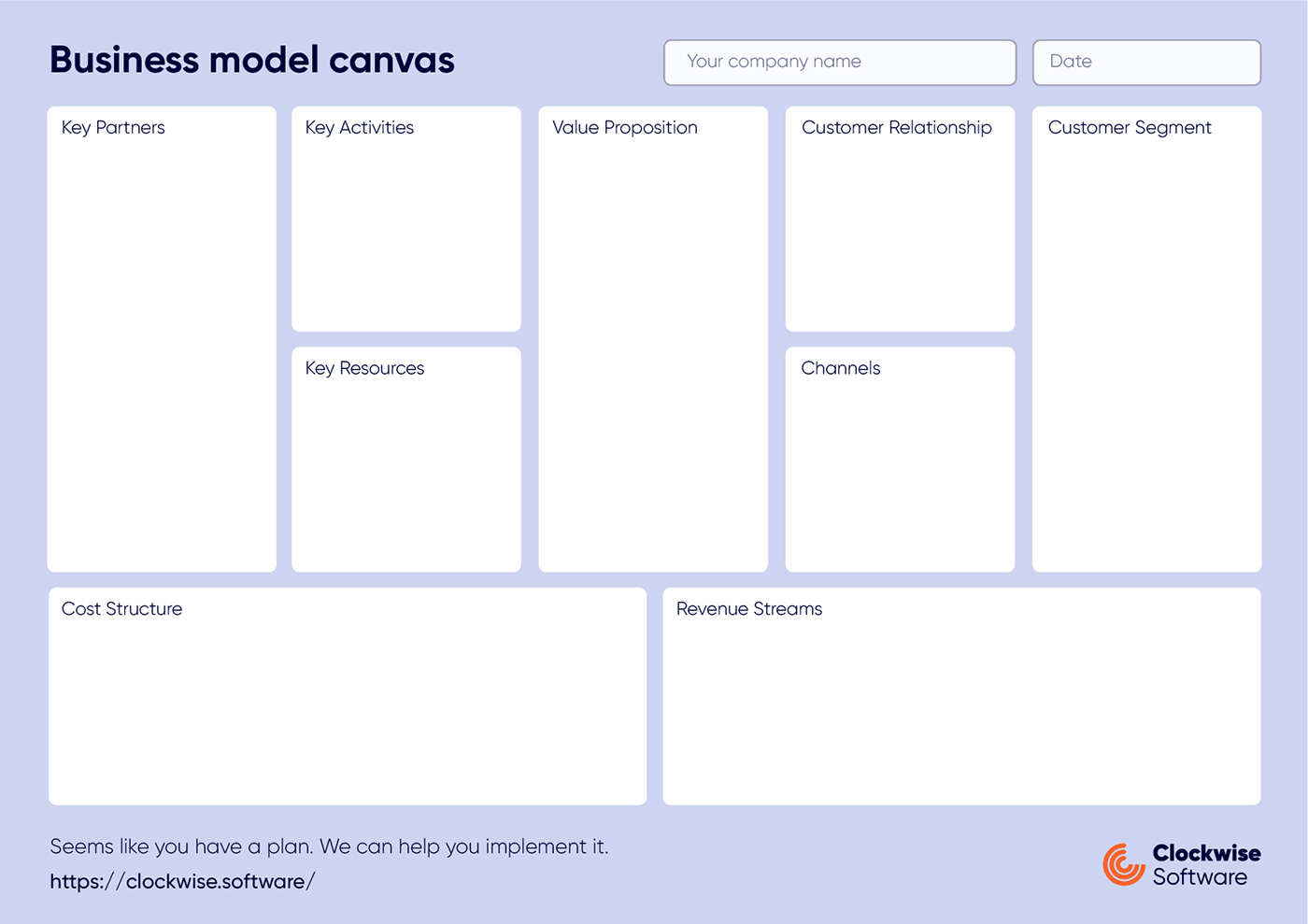
A business model canvas contains key information about your project’s specifics, your requirements, and your expectations. It also helps you estimate if the resources currently at your disposal are enough for implementing your project. As you fill out the business model canvas, you can use it to pitch your idea to angel investors and approach a software development team who can implement your idea.
Once you have shaped your idea, you can start thinking about what features to add to your MVP to meet the needs of your first customers.
To create the first version of Mailchimp, Ben Chestnut reused some old code he had written for a failed digital greeting card product. This code became the starting point for the large and feature-rich Mailchimp platform as we know it. Ben and Dan weren’t trying to spend all the resources they had on creating Mailchimp’s first version. Instead, they chose to build a product that had only one core feature (email automation), investing minimal resources.
Mailchimp was created in response to the needs of small business owners that wanted to reach out to their customers via email in the most effective and affordable way possible. After the initial requirement was met, the founders started to slowly endow their platform with new features and tools in accordance with customers' growing requirements.
Developing an MVP means focusing on the main features, which you can determine through your market research. What do your competitors lack? What are your target audience’s main needs? Don’t be afraid of launching too primitive a product. As you see that your service delivers value to your customers and they want to pay for it, you can start adding new features.
You can start by solving a common problem of your users with a traditional feature. However, some innovative features can bring you success as well. For example, Mailchimp added an AI-powered Creative Assistant that can take information from a user’s website and use that information to create brand-related images for social media posts. At the time of its launch, Creative Assistant had no analogs on the market. Almost 5 million designs have been created instantly by Mailchimp’s users with the help of this feature.
What feature can potentially turn your startup into a unicorn? Can you solve a problem that’s currently neglected by top industry players? Answer these questions when building your MVP.
Mailchimp’s design is unique and recognizable. In a world where most business platforms are formal and look alike, Mailchimp provides an unusual, creative, and playful design with a relaxed vibe. Users encounter lots of quirky and fun images and animations on the Mailchimp website.

Mailchimp website
Ben Chestnut and Dan Kurzius started off as web designers, and design was a strong point for them when creating Mailchimp.
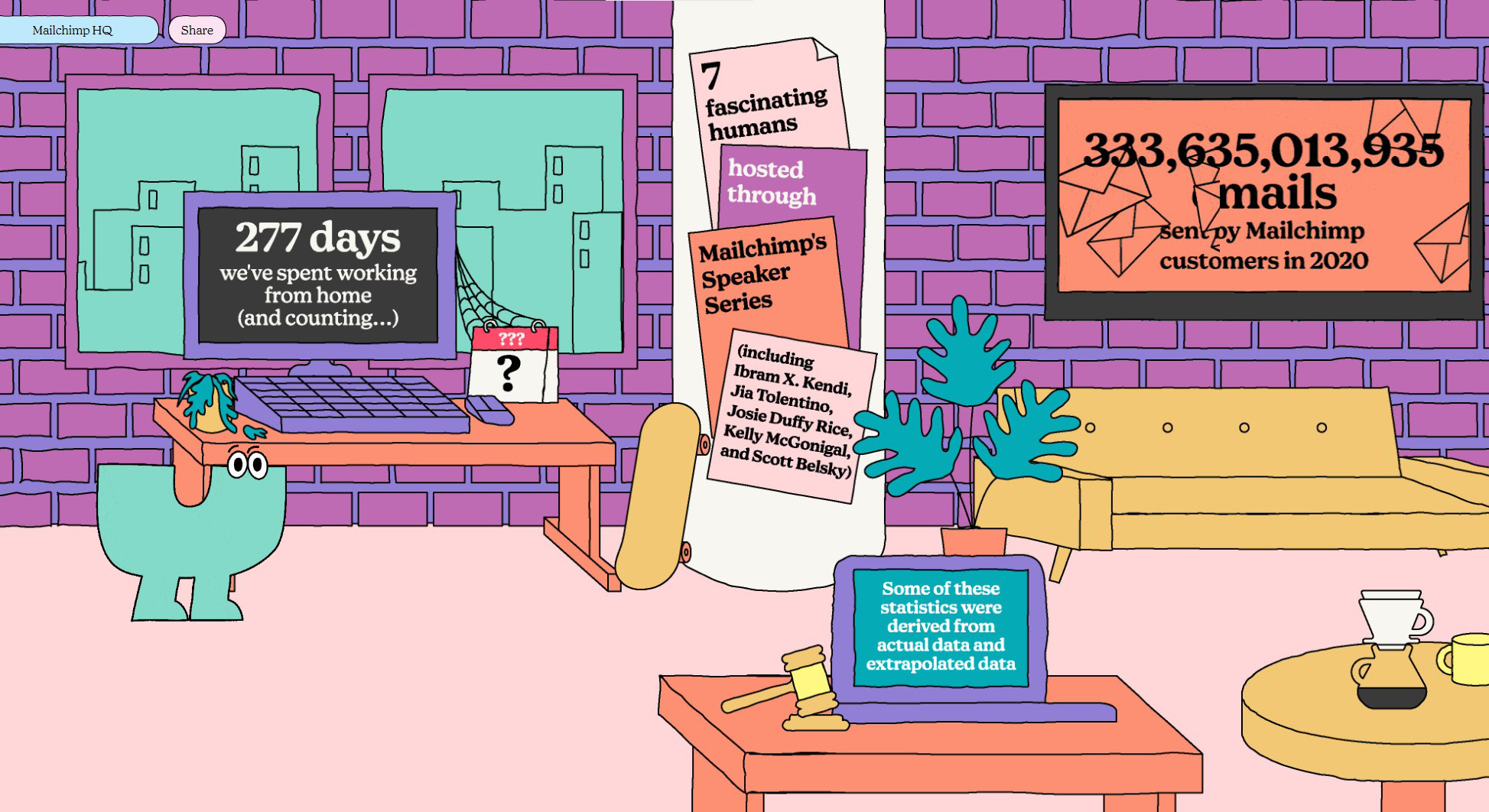
Mailchimp's 2020 annual report
When developing the design of your email service like Mailchimp, you need to work out the user interface and user experience. How can you do that?
The user interface, or UI, refers to buttons, icons, sections, loaders, and other visual elements that the user interacts with when using a product. Before the actual development process starts, you need to understand what the user interface will look like. Prioritize the main features, and don’t overload your product with unnecessary elements.
Discuss your vision with UI/UX designers. They can create an interactive prototype and shape it until you and your design team agree on how the user interface should look.
The user experience, or UX, refers to all of a user’s interactions with the software product. The main goal of UX design is to provide effective, sleek, and intuitive interactions between the user and the service. Even if your email service like Mailchimp looks attractive, people will probably not want to use it if it loads slowly or has too many confusing sections and ambiguous elements in the menu. When starting your project with an MVP, you should focus on simplicity and responsiveness.
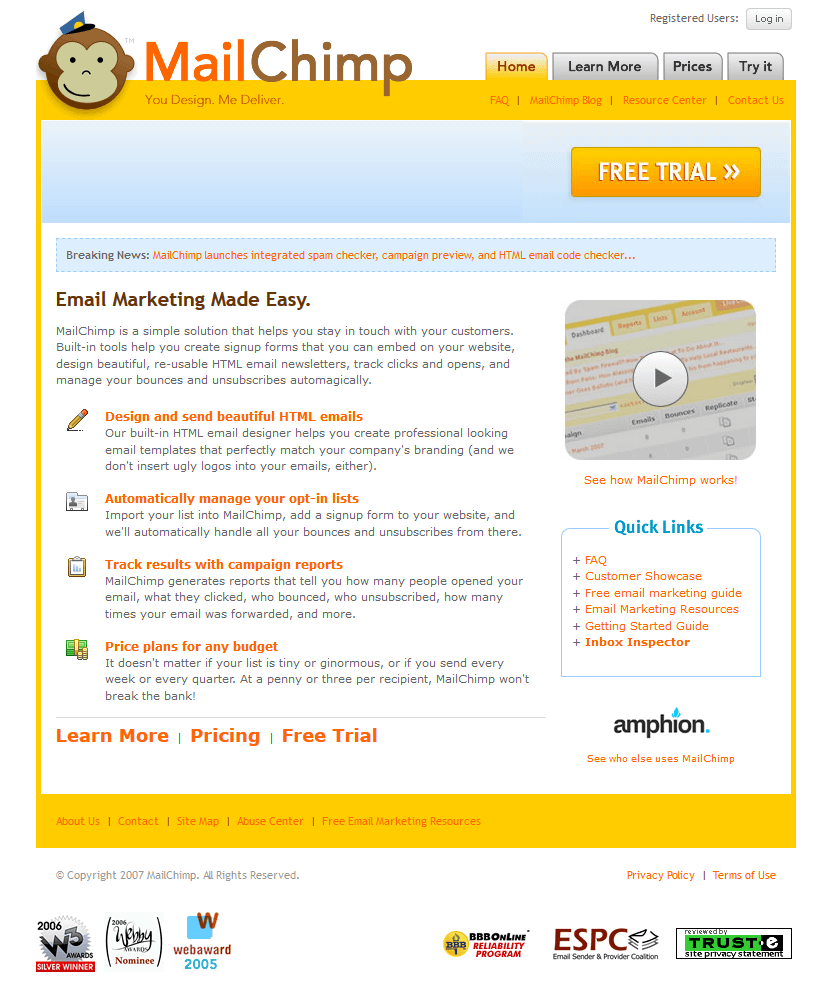
Mailchimp website in 2001
In 2001, when Mailchimp was launched, its website looked sleek, clean, and understandable. Users could easily find information about the service’s benefits and could start using it instantly.

Mailchimp website in 2022
What you can learn from Mailchimp is that you need to find a way to separate yourself from your competitors, and a unique and catchy design is a good weapon for that. For example, if you create a platform with a simple and intuitive interface, it can become your competitive advantage over other popular email marketing services that have complex interfaces and don’t provide a seamless UX for inexperienced users.
Don’t overplay trying to make your design stand out: the key to a successful MVP is minimalism and a convenient user experience. By focusing on delivering a sophisticated and rich design in the very first version of your service, you will only waste resources.
Your choice of technologies for implementing your idea primarily depends on your goals, possibilities, and budget. Your email marketing solution should be scalable, high-performance, and have exceptional security to protect your clients’ sensitive data. Email marketing services work with millions of email addresses and must put a lot of effort into keeping their users’ data safe.
Discuss your product’s architecture with your software architect; it should be scalable so you can easily upgrade your product as your users’ needs and requirements change.
Your frontend and backend developers should find the optimal technology stack to implement your idea.
QA specialists should conduct manual testing to make sure the product works smoothly and meets the initial requirements. A project manager can control the development process and keep you informed about the progress.
The MVP for your custom email service like Mailchimp can be built by your in-house team, an outsourced team, or freelancers. If you’re starting from zero and lack the needed engineering and product management expertise, you can outsource your project to a software development company. Read our articles about Dedicated development team and IT outsourcing to find out more about these options and choose the optimal one for you.
When your team finishes developing your MVP app, it should be delivered to end users either through app stores (Google Play, Apple App Store) or as a web application accessible from any browser.
After your first users experience your new email marketing app, you should collect their feedback and measure the software’s performance.
The main purpose of starting a project with an MVP is to reduce the initial investments and time to market. It’s much better to improve a product based on real user feedback than to build an email marketing strategy based on gut feelings.
It’s important to establish communication with your first users to have a clear understanding of what you should do next. Maybe you will have to work on your existing features or add new ones. If you don’t reach the results you expected, you may have to pivot and build a completely different version of your app with new features, a new target audience, or new goals.
But how can you measure the results of your MVP launch? First of all, you need to pay attention to how useful your product is for users, what users like about it, and what they don’t like. Secondly, you need to monitor important metrics:
By analyzing these metrics, you can find out how successful your product is and whether it’s worth continuing to put resources into product upgrades and maintenance.
An MVP is only the first step to a profitable startup. If you want to grow and achieve more success, you need to support and maintain your product, add new features, and improve existing ones.
With time, your customers’ needs will inevitably change, and so will the market. An MVP is only the beginning of your journey; it’s created to gather user feedback so you can then upgrade your product.
Of course, there are some clear concerns about the longevity of email. Mailchimp keeps on developing other channels as well to make sure that their service won’t be pushed away by newcomers offering more innovative marketing solutions. And we are sure that they will continue in this direction. In 2017, Mailchimp unveiled partnerships with Facebook, Instagram, and Google, allowing users to buy Facebook ads and Google retargeting ads within Mailchimp software. Thanks to this, users can build their customer lists with less effort.
Ben Chestnut and Dan Kurzius claim that their main goal is for Mailchimp to remain an all-in-one marketing solution for small businesses.
When you serve small business, the churn rate is awful. Fifty percent are dead within five years. You’re constantly having to innovate really, really fast. You just have to tinker, tinker, tinker, tinker, tinker.
Ben Chestnut, interview for Inc
As we mentioned, Intuit bought Mailchimp in 2021 for $12 billion. Being backed by Intuit’s software ecosystem, Mailchimp is on its way to evolving from a SaaS email marketing platform to an overall SaaS marketing platform providing the world’s best solutions for small businesses.
If you want to build a service like Mailchimp, you should never forget about growth.
The secret is not in mimicking Mailchimp. It is in responding to the current market needs. You can build a SaaS email marketing platform that will be more accessible and convenient for your users than services provided by your competitors.
Let’s look through the lessons you can learn from Mailchimp to create your own successful product.
As our product and team continues to grow, one thing stays the same: Ben and Dan’s mission to empower the underdog.
The whole history of Mailchimp started when Ben Chestnut and Dan Kurzius simply wanted to help their customers without thinking about income. Investors always wanted them to pivot to enterprise software because the user base and immediate returns would be larger.
The key reason for Mailchimp’s success is not an enormous budget, attention from investors, clever marketing moves, or anything like that. It’s the attitude of the founders towards their clients. They weren’t looking for ways to get rich as fast as possible or turn Mailchimp into the number one brand in the email marketing world. They were trying to give their customers what they wanted and do that as quickly as possible.
Ben Chestnut and Dan Kurzius have remained loyal to their customers since the very beginning. Mailchimp still supports small businesses at their first stage of growth, allowing them to send up to 1000 emails per month for free.
Mailchimp started as a paid tool, and customers were willing to pay for the services Mailchimp provided. Still, Mailchimp switched to a freemium model in 2009. The decision was definitely risky. But were Ben Chestnut and Dan Kurzius crazy? No. They were testing and analyzing different payment models and eventually concluded that implementing a freemium model would be the best decision.
We had about a few hundred thousand users on the system, and within a year it was a million… Within another year, it was two million. And it just kept growing from there. Freemium-and focus had worked.
Ben Chestnut, interview for Inc.
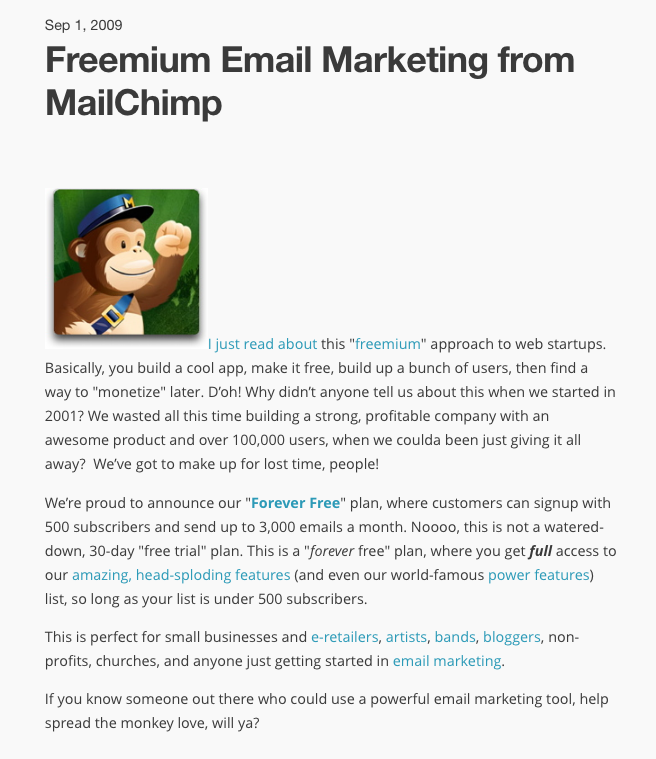
Announcement of transition to Freemium model made by Mailchimp founder in 2009
The transition to freemium was made with Mailchimp’s users in mind. Ben Chestnut knew that some of their clients would want to switch to a free plan if they could. Small growth-stage businesses with a small user base could significantly benefit by using Mailchimp for free.
Let’s just make the whole thing free. If your customers are small businesses, make it easy and cheap for them to try you out. That means they’ll be happy once they have to pay for your services, because it means their business is growing.
Ben Chestnut, interview for Inc.
However, this doesn’t mean that freemium is the best model for entering the market with your SaaS email marketing startup. Mailchimp started as a paid service and then switched to freemium to gain more customers. The choice of monetization model requires analysis.
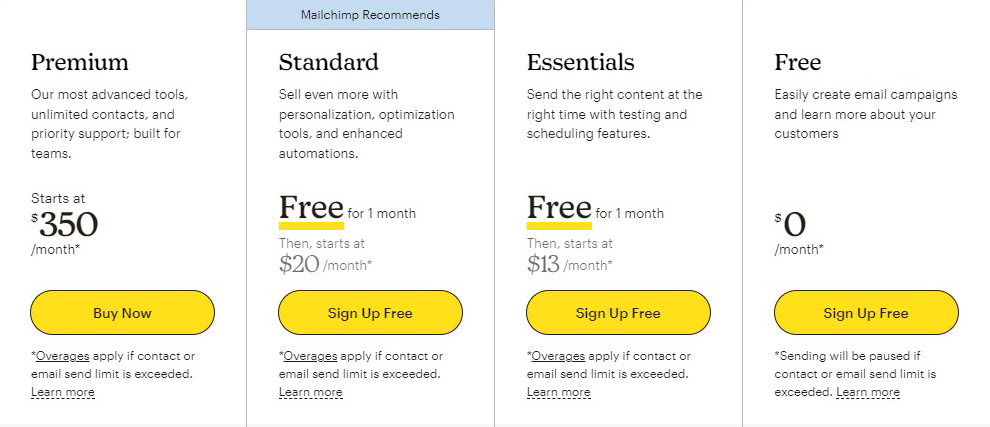
Mailchimp plans for businesses at different stages
Mailchimp uses a SaaS business model to deliver their services. And by going with a SaaS model as well, you can offer both cheap solutions for small businesses and more expensive solutions for advanced businesses.
The Mailchimp logo features a chimp named Freddie. But how did the founders get this idea? Freddie the chimp was on one of the online greeting cards Ben Chestnut created when was trying to launch a digital greeting card product, and this chimp has served as the Mailchimp logo and inspired the Mailchimp brand.
At first glance, the logo doesn’t mean anything. But if you dive a bit deeper, Freddie’s playful mood symbolizes the simplicity and creativity with which Mailchimp’s clients can use the service, taking advantage of its automatic features and friendly user interface. The Mailchimp logo doesn’t explain anything about the company and doesn’t tell which industry it belongs to, but Freddie is strongly associated with Mailchimp.
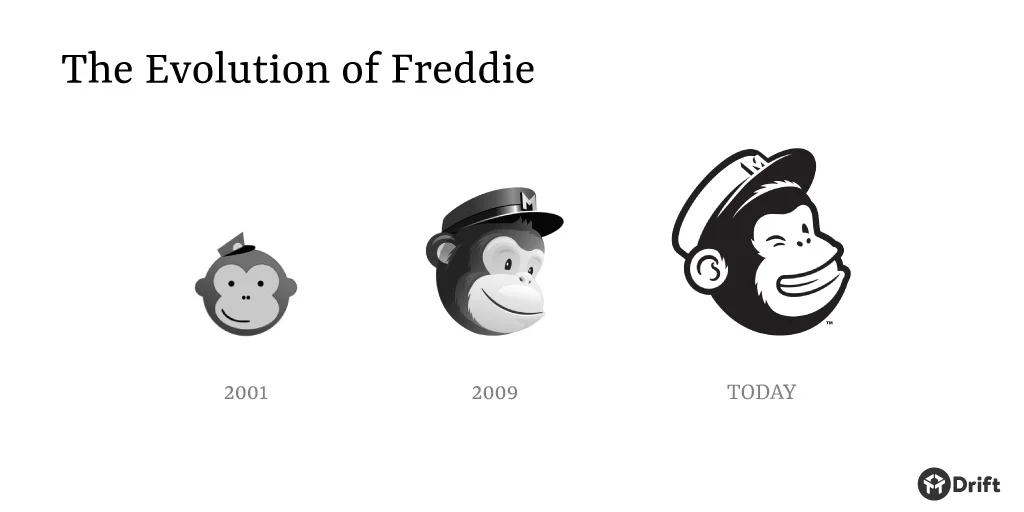
As you can see from the example of Mailchimp, a logo doesn’t necessarily have to be informative; rather, it has to be associated with your company and reflect your company’s values, culture, and attitude towards clients. The email marketing industry is competitive, which makes it hard to find ways to stand out from your competitors. Bear in mind that a logo is far more than an image and font. You can use your logo to make your customers perceive your brand the right way.
I kind of feel like I had my head down, tweaking things, improving things, and then I looked up and bam, it’s a $12bn company.
Ben Chestnut, interview for Financial Times
At the beginning of their journey, Ben Chestnut and Dan Kurzius didn’t have a huge budget. Their idea didn’t seem striking to investors. But nowadays, Mailchimp is an indisputable leader in the email marketing field.
Mailchimp’s founders didn’t consider pivoting to become another marketing platform for enterprise companies. Instead, they filled the gap in the market for an affordable marketing solution for small businesses and became incredibly successful in their field.
What can you learn from Mailchimp for your own SaaS email marketing platform?
FAQ
Email marketing software allows users to plan, create, and send emails to their customers.
According to Statsita, Salesforce Marketing Cloud, Mailchimp, and Adobe Marketo are the leading email service providers for marketing purposes.
The main steps in email marketing platform development are researching the market, shaping your idea, prioritizing features for the MVP, designing the UI/UX, and developing the MVP.
